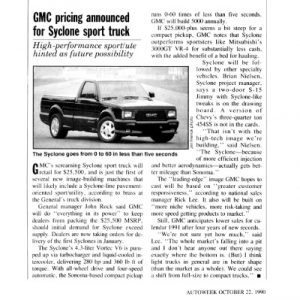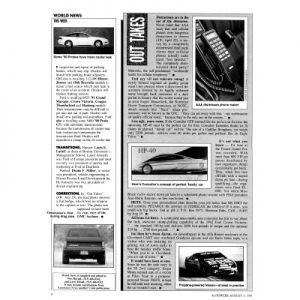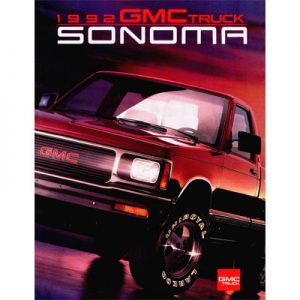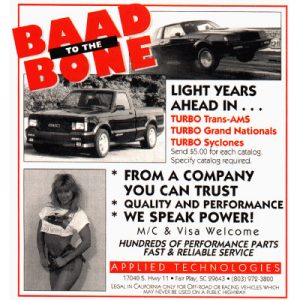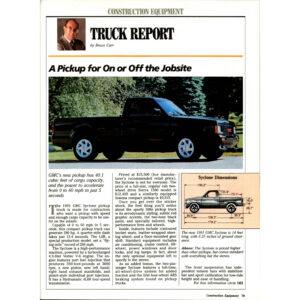Turbo & Hi-Tech Performance
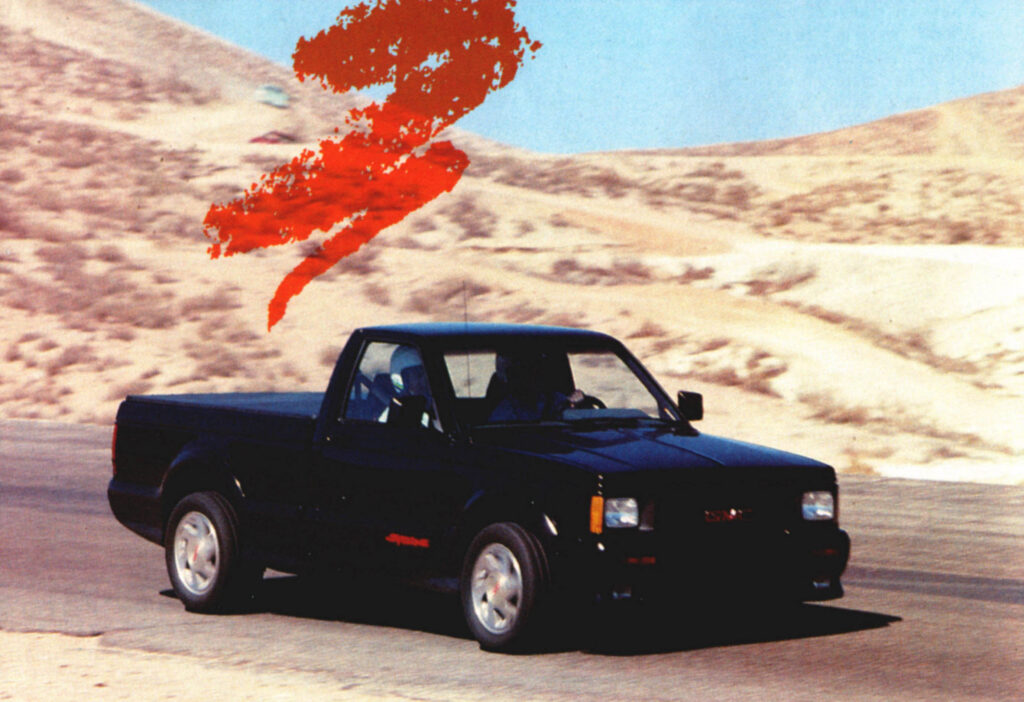
Figures don’t lie. And figures like zero-60 in 4.9 seconds and 13.1 second quarter miles at over 100 mph would be impressive for a 300Zx, Stealth or Corvette ziti. But in this case, the figures belong to a compact pick-up truck.
In January 1991, the high-performance GMC Syclone will he available at GMC Truck dealerships nationwide. It is based on the GMC Sonoma compact pick-up, which made its debut as a concept vehicle at Detroit’s North American International Auto Show in 1989, where it received tremendous attention.
The real story of the Syclone began over three years ago when a handful of highly motivated young GMC engineers conceived the project. As GMC Truck director of Marketing Rick M. Lee noted, the project was fueled by the fact that increasing numbers of “former car owners” are coming over to trucks. At that time, research indicated that over a million buyers annually switch to trucks. This meant there was a real market for an OE performance truck.
So the small GMC team set about to create a “total performance” sport compact pick-up. Certain criteria were first established. It had to make a statement. It had to be the best in its class. And in this case, the best meant: safety, ride handling and traction, fit and finish, and all with a full factory warranty and financing available.
What the Syclone team came up with is a two-door, two-passenger sports car with a pick-up bed on the back! Standard equipment includes: air conditioning, power windows and door locks, AM/FM stereo cassette, tilt wheel, intermittent wipers, analog gauges (including a 140 mph speedo), cruise control and tinted glass. On the bed is a Lexxus TruxCover tonneau cover, also standard. The tonnean cover snaps to an aluminum frame attached to the truck bed without drilled holes.
The interior is replete with contoured sport bucket seats, a floor-mounted shifter, center console with cup holders, a storage compartment, leather wrapped steering wheel and a Syclone insignia.
The truck is Lamp Black with subtle red accents. Aerodynamically styled body panels not only enhance the visual effect of the truck, but aid in freeway handling, and cover the fat Firestone 245/50VR-16 rubber on 8×16 aluminum wheels.
The Syclone’s visual impact pales somewhat when your attention turns to the mechanical aspects of this Porsche hunter. All the right ingredients have been added to create one of the fastest, best handling, and most exciting vehicles ever produced in this country.
Leading edge technology is employed in every area of the truck’s engine, suspension and drive train. Starting with the strong 4.3-liter Vortech V-6, a complete makeover begins at GM’s Romulas, Michigan, plant. There it receives new alloy pistons (8.35:1 instead of the 8.5:1 standard cast pistons) and a left hand/right hand split manifold before being hot tested.
Next, the engines are shipped to one of GMC’s partners in the Syclone project, PAS, Inc., at their Shreveport, Louisiana, plant. PAS, a Troy, Michigan, based engineering firm, specializes in small-volume automobile manufacturing. They add the “pow” to the Syclone’s power, including: electronic multiport fuel injection, iron exhaust manifolds with front-mounted exhaust crossover tube and a Corvette L98 throttle body.
All this hardware results in a powerplant that creates 280 horsepower at 4,400 rpm, with torque reaching 360 lbs/ft at 3,600 rpm. GMC engineers indicate that the Syclone will get better gas mileage than the stock 4.3 because of the port fuel injection used instead of the standard throttle body injection on other GMC models.
To transmit all that power to the ground efficiently, the Syclone receives full-time all wheel drive. Don’t confuse this with traditional four wheel drive for trucks. This system is similar to that used on the 1991 GMC Safari L-van, and consists of a single-speed viscous-coupler transfer case from Borg-Warner. Plus a four speed 700R4 automatic transmission from Corvette. The torque split is set at 35 percent to the front and 65 percent to the rear, with special transmission gearing for the Syclone. The complete powertrain is then shipped over to the GM assembly plant in Shreveport where it is mated to the chassis.
Using the same front differential and axles as those on the all wheel drive GMC Safari van, the chassis is assembled with a limited slip rear differential with a 3.42:1 ratio, the same gear ratio as up front. A four wheel, anti-lock brake system (a first for trucks) completes the package, with front discs and rear drums.
To make sure the truck handles as well as it moves, the stock ride height was dropped about 2.5 inches. Torsion bars up front and leaf springs in the rear are complemented with Bilstein shocks and a 32 mm anti-sway bar on the front end.
We recently had an opportunity to get some “hands on” time with the Syclone at Willow Springs Raceway. The esthetic appeal of the truck is immediate. But the real thrill comes when you get behind the wheel of the “E-ticket” truck and press down on the pedal.
Though the raceway didn’t offer the advantage of a standing quarter-mile run for acceleration, there was no doubt that the records previously set at the strip in Detroit could be equaled by this unit. The advantage here, however, was the chance to see how the truck worked under pressure.
Into the first turn, the natural reflex was to let off on the gas a little, tap on the brake just so, and punch it through the turn. With this truck, that was unnecessary. The all wheel drive split is near perfect for the power; the Syclone seems to follow the curves and corners the best when driven fast and faster. With the revs kept up, the turbo boost is maintained, and the same theory that pulls front wheel drive vehicles around corners comes into play–with a rather large “push” from the rear. This very trackable stance would give one greater confidence and control under rain and snow conditions. And of course the ABS brakes will insure that you can stop as well as you can go.
There are a couple of areas where the Syclone may not compare to many high-priced sports cars, but it is a truck. Considering the fact that the truck has a curb weight of 3,526 pounds, with an extremely poor weight distribution figure of 64 percent front and 36 percent rear, it still handles better than any other truck.
Another area that needs improvement is the ECM. The factory shift point is around 4,200 rpm, with a fuel cutoff at about 4,400 rpm. This area will no doubt be addressed by the aftermarket with new PROM chips. Higher boost pressures can be attained with some reworking of the engine management systems that could result in quarter mile times that would threaten even some of the hot Grand Nationals.
So what’s the price for all this fun and excitement? At press time, GMC officials are saying $25,500 “and we don’t want the dealers to gouge the buyer.” The first year’s production will be 2,000 to 2,500 units, with nationwide availability.

